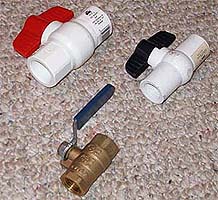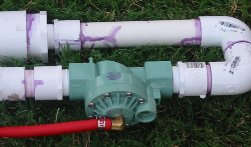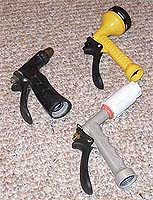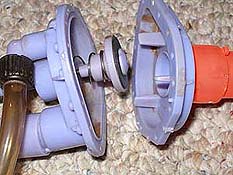Firing Valves
Written by Drenchenator
Last updated on 2007-08-18
- Introduction
- Comparison
- Ball Valves
- Solenoid Sprinkler Valves
- Hose Handles
- Pull Valves
- Homemade Valves
Introduction
The firing valve in a homemade soaker or water balloon launcher greatly enhances or weakens the gun's performance. A water gun requires a different valve than a launcher because shooting liquids differs from shooting solids. In a water gun, laminar flow is essential; in a launcher, valve opening speed is. Without laminar flow, a water gun stream flows wildly. Without a fast valve, a launcher's projectile does not accelerate as well.
Comparison
| Type | Flow | Opening Speed | Price | Availability | Sizes | Recommended Use |
| Ball | Laminar | Very Slow | $1 to $20 | Stores | All | Water guns |
| Solenoid Sprinkler | Turbulent | Fast | $15 to $20 | Stores | 3/4" and 1" | Launchers, Nerf guns |
| Hose Handle | Turbulent | Slow | $1 to $10 | Stores | 3/4" only | Nerf guns, water guns |
| Pull | Turbulent | Slow | Not Sold | Unavailable | Limited | Water guns, Nerf guns |
Ball Valves
 The cheapest and most available valve is a ball valve. Inside of the valve is a small ball with a hole through it. A quarter-turn of the handle activates the valve. When closed, the hole does not align with the ends of the valve. When opened, the hole lines up with the ends and the fluid flows through. This operation maximizes laminar flow by allowing the straightest path possible for a fluid. Accordingly, a ball valve is the best firing valve for a water gun.
The cheapest and most available valve is a ball valve. Inside of the valve is a small ball with a hole through it. A quarter-turn of the handle activates the valve. When closed, the hole does not align with the ends of the valve. When opened, the hole lines up with the ends and the fluid flows through. This operation maximizes laminar flow by allowing the straightest path possible for a fluid. Accordingly, a ball valve is the best firing valve for a water gun.
Ball valves are made of metal or plastic. The most common metal is brass; the most common plastic is PVC. Metal valves open more quickly and more easily; PVC valves weight and cost less.
Though ball valves perform wonderfully in water guns, they operate poorly in launchers. They open very slowly.
Solenoid Sprinkler Valves
 Sprinkler valves are a fast and available valve. These valves were intended for sprinkler systems. They can be activated two ways: electronically and pneumatically. Most valves open when subjected to 24V AC. However, a common modification opens them with a push of a button. Solenoid sprinkler valves should be used in launchers and Nerf guns.
Sprinkler valves are a fast and available valve. These valves were intended for sprinkler systems. They can be activated two ways: electronically and pneumatically. Most valves open when subjected to 24V AC. However, a common modification opens them with a push of a button. Solenoid sprinkler valves should be used in launchers and Nerf guns.
Hose Handles
 An obvious choice for a water gun valve is a hose handle. A hose handle works like a pull valve: a small seals retracts, opening the valve. Hose handles fit 3/4" female pipe and were designed for gardening. Nonetheless, some hose handles break easily. Furthermore, they have low, turbulent flow due to an extremely small internal diameter and large bend.
An obvious choice for a water gun valve is a hose handle. A hose handle works like a pull valve: a small seals retracts, opening the valve. Hose handles fit 3/4" female pipe and were designed for gardening. Nonetheless, some hose handles break easily. Furthermore, they have low, turbulent flow due to an extremely small internal diameter and large bend.
Hose handles come in three varieties: single-nozzle, multi-nozzle, and threaded-nozzle. Threaded-nozzle versions support custom nozzles.
A simple modification can increase flow in a hose handle. Many nozzles use a small metal piece to shape and form the stream. When removed, more output occurs because the cross sectional area of the valve is greater.
Pull Valves
 Most Super Soakers built before the Max-D line used pull valves. In a pull valve, a retractable seal pushes against another seal. When the retractable seal is pulled back, the valve opens. Homemade versions of this valve have been made before. However, pull valves lack laminar flow; the water must flow around the seal. Moreover, they cannot be bought.
Most Super Soakers built before the Max-D line used pull valves. In a pull valve, a retractable seal pushes against another seal. When the retractable seal is pulled back, the valve opens. Homemade versions of this valve have been made before. However, pull valves lack laminar flow; the water must flow around the seal. Moreover, they cannot be bought.
Homemade Valves
Homemade water guns and launchers have entered a new age with the introduction of homemade valves. Now, builders can craft valves with more options than conventional valves. Pull valves and piston-style pull valves have been built in the past; the future is wide open.